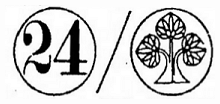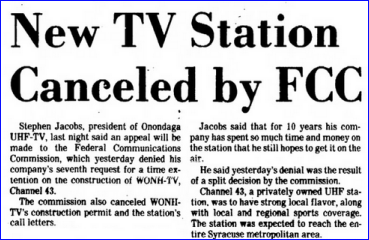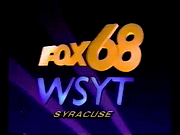by Scott Fybush
Of all the sizable TV markets in upstate New York, Syracuse was by far the last to get commercial UHF television that lasted. Why did it take 34 years between the launch of UHF in 1952 and the sign-on of WSYT on channel 68 in 1986? Syracuse is, after all, not much smaller than Buffalo, where two UHF stations took to the airwaves in 1953 and one at least survived, if not thrived. It is nearly identical in size to nearby Rochester, where UHF construction permits came and went between 1953 and the debut of WUHF on channel 31 in 1980. It's larger than Albany, where tight spacing to bigger cities meant a decade of intermixed operation before two fairly successful UHF stations got moved to VHF.
Is the answer as simple as the luck of the draw that made Syracuse the only upstate market with two VHF stations before the freeze? WHEN-TV/8 was first to the game in 1948, and WSYR-TV/5 was a pre-freeze grant that was built out and turned on in 1950, after the freeze had already gone into effect. (By contrast, Rochester's WHAM-TV and Buffalo's WBEN-TV enjoyed pre-freeze monopolies, allowing potential competitors to decide whether to go for a speedy grant on UHF or face the possibility of a lengthy comparative hearing when a second VHF was allotted to each market at the end of the freeze.)
By the time the freeze began to thaw in 1952, WHEN-TV and WSYR-TV were evidently so dominant in their market that few competitors emerged with even the most modest expressions of interest in adding a third TV voice. When the FCC released its Third Notice with proposed post-freeze VHF and UHF assignments (including WSYR-TV's shift from 5 to 3), only one Syracuse broadcaster submitted a counterproposal to the Commission's plan that would have added only educational channel 43 to the market. WAGE Inc., which operated WAGE/620 in Syracuse, offered a plan to add channel 11 to the market, moving a tentative 11 allotment in Ottawa to channel 5. WAGE's plan conflicted with a proposal from the Brockway Corp. to put channel 11 in Watertown, 70 miles to the north, as that small city's first TV allocation.
When the dust settled, the FCC accepted neither proposal; in Watertown, it replaced a tentative channel 35 allocation with channel 48, allowing 35 to be used in Troy for what would become WTRI-TV (and eventually WAST/WNYT on 13). Brockway ended up with channel 48, but found a new VHF home on channel 7 for what would become WCNY-TV and later WWNY-TV. (Channel 11, for its part, landed in nearby Kingston ON shortly afterward as CKWS-TV.)
Only educational channel 43 remained on the allocations table, and as with most upstate New York markets, it was soon filled (at least on paper) by a placeholder CP granted to the State University of New York on September 18, 1952, with callsign WHTV.
Even WAGE got its TV station ... or rather, Meredith's WHEN-TV got its radio station. By March 1954, Meredith paid $200,000 to buy out WAGE Inc., removing the one potential radio competitor for the time being against the TV duopoly of WSYR and WHEN. (If Syracuse was better endowed with TV than most comparable markets, it was perhaps somewhat underpowered on the radio dial; aside from WSYR and WAGE/WHEN, only three other AM stations competed seriously for a mass audience. Beyond the obvious answer of a market dominated by WSYR and WHEN, augmented by nearby VHF outlets in Utica, Watertown, Binghamton and Rochester, were there other reasons why venerable WFBL/1390 and its 1940s-era competitors, WNDR/1260 and WOLF/1490, did not seek TV outlets?)
At this point, the history of UHF TV in central New York all but stops dead for more than a decade, enlivened only briefly by a brief 1960 attempt by Massachusetts-based Springfield Television to move a dormant channel 37 allocation in Clymer, near Jamestown, up to Syracuse.
A realignment of UHF allocations in the mid-1960s shifted SUNY's WHTV permit from *43 to *24, a channel made available in Syracuse after the deletion of WTVE in Elmira, 80 miles to the southwest. After its brief existence was ended by a storm, WTVE tried and failed to get moved to the VHF dial on channel 9, and a 1962 realignment on the VHF side shifted WHEN-TV to channel 5 and opened channel 9 for a pile of applicants in Syracuse. As in nearby Rochester, the competitors formed an interim joint licensee to put WNYS(TV) on the air quickly as an ABC affiliate, leaving little competitive room for any new prospective UHF operator.
The allocation of channel 9 prompted the FCC to revisit the Syracuse UHF dial, asking for comment in early 1962 on a plan that would have removed channel 33 from Batavia and 48 from Watertown, moving both to Syracuse in place of the proposed channel 37.
 Channel 24 reached the air in Syracuse in 1965, activated by a community group as WCNY-TV from a tower in Pompey shared with the new channel 9. Commercial UHF, however, would be slower to arrive. In February 1966, "Channel 30 Inc," a sister company to FM newcomer WONO/107.9, applied for a 235 kW signal on channel 30, which had been allocated in the same shuffle that put *24 in Syracuse. "Channel 30 Inc." became "Onondaga Television Inc." when the FCC again rearranged the table later in 1966, replacing 30 and *43 with a new Syracuse lineup of 43 and 62. On February 2, 1967, Onondaga's revised application for channel 43 was granted, proposing a studio and transmitter location at Sentinel Heights adjacent to WSYR-TV's tower.
Channel 24 reached the air in Syracuse in 1965, activated by a community group as WCNY-TV from a tower in Pompey shared with the new channel 9. Commercial UHF, however, would be slower to arrive. In February 1966, "Channel 30 Inc," a sister company to FM newcomer WONO/107.9, applied for a 235 kW signal on channel 30, which had been allocated in the same shuffle that put *24 in Syracuse. "Channel 30 Inc." became "Onondaga Television Inc." when the FCC again rearranged the table later in 1966, replacing 30 and *43 with a new Syracuse lineup of 43 and 62. On February 2, 1967, Onondaga's revised application for channel 43 was granted, proposing a studio and transmitter location at Sentinel Heights adjacent to WSYR-TV's tower.
WONO moved slowly to get its new station, dubbed WONH, on the air. In June 1968, the FCC gave Onondaga a 30-day notice to show cause why the CP should remain active. Despite appeals, the Commission's patience appeared to finally run out in August 1969, when it denied WONH a "final" extension to the CP. Somehow, WONH survived, winning repeated CP extensions throughout the early 1970s.

Syracuse News-Journal report on the cancellation of WONH/43's CP in
1975. It was later reinstated on appeal and sold in 1980. It finally
went live in 1989 as WSNR; the CP was 22 years old at that point. |
Along the way, WONH had acquired studio equipment, which it began selling off in classified ads in Broadcasting in 1972. The Onondaga partners had by then sold off WONO as well, but they soldiered on with attempts to put channel 43 on the air. On December 5, 1975, the FCC Broadcast Bureau cancelled WONH's CP and deleted its callsign, but the station would not stay dead: In February 1976, the bureau accepted Onondaga's appeal, reinstating the CP and scheduling an oral hearing to see whether the company (by now "Onondaga UHF-TV Inc.") had suffered failures outside its control that kept the station from signing on.
On March 25, 1977, it finally appeared to be all over, as the FCC's Review Board denied a seventh request for an extension of time, deleting the CP that had by then lingered on the books for more than a decade. But WONH had an eighth life, and then some, remaining active as a CP into a new decade, under new owners and calls.
After 13 years holding an unbuilt CP, Stephen Jacobs and his partners Henry Fogel, Howard Hall, Richard Wells and Albert Lintel Jr. finally saw a return on their investment in February 1980, when they sold the facility to American International Communications of Syracuse (a partnership of American International Pictures and Harvey Seslowsky) for $150,000.
The 1980s brought exciting changes to channel 43 in every way short of actually going on the air. American International became Filmways and then Orion TV Broadcasting, and in October 1985 it filed to sell the still-unbuilt CP to Richard Shively and John B. Tupper for $436,500. Shively and Tupper brought to the table the proven ability to actually build functioning UHF TV stations, having constructed WEVV in Evansville, Indiana and WXMI in Grand Rapids, Michigan.
WFWY bought programming, or at least allowed syndicators to use its callsign in ads. It changed that callsign again in 1988, becoming WSNR. In April 1989, it applied for new facilities that barely qualified as full-power, just 17.8 kW from a high-rise apartment building at 989 James Street, across the street from the studios of channels 3 and 5. And in October 1989, more than 22 years after the initial channel 43 CP was issued, a signal finally made it to the airwaves from WSNR. By then, ownership had once again shifted: the station belonged to Salt of the Earth Broadcasting, a religious broadcaster owned by attorney James L. Oyster of Virginia. And by then, a view across James Street from the channel 43 antenna would have looked down not only at channels 3 and 5 but by another UHF signal that got a much later start, but beat channel 43 to the air by three years with a much bigger signal.
In March 1982, the vacant channel 62 allocation was granted to Great Onondaga County Telecasting, which initially planned to put subscription TV on the channel, newly dubbed WKAF. By early 1986, the permittee was "Syracuse Channel 62 Inc.," headed by Douglas Ruhe out of Nashville, and the station was ready to take the air as an early affiliate of the new Fox network. But before WKAF could sign on, it had to change channels to the newly-allotted 68, making room for a swap downstate that shifted new independent WTZA from 63 to 62.
 On February 15, 1986, the new WSYT made it to the air on channel 68, transmitting from a 1000-foot tower near Skaneateles, considerably farther south than the city's existing stations. With a megawatt of power, though, the new signal blanketed a big swath of central New York. After a brief start with just a few hours of religious programming each day, the station was sold to New England real estate developer Thomas J. Flatley in July 1986. Flatley completed construction on a new studio at 1000 James Street, right between channels 3 and 5, and by late 1986 channel 68 was a full-time Fox affiliate, filling the rest of the day with syndicated fare, movies and Yankees baseball.
On February 15, 1986, the new WSYT made it to the air on channel 68, transmitting from a 1000-foot tower near Skaneateles, considerably farther south than the city's existing stations. With a megawatt of power, though, the new signal blanketed a big swath of central New York. After a brief start with just a few hours of religious programming each day, the station was sold to New England real estate developer Thomas J. Flatley in July 1986. Flatley completed construction on a new studio at 1000 James Street, right between channels 3 and 5, and by late 1986 channel 68 was a full-time Fox affiliate, filling the rest of the day with syndicated fare, movies and Yankees baseball.
In 1994, James Oyster sold channel 43 to local broadcasters Craig Fox and George Kimble, operating as Metro TV Inc. from the studios of WOLF/1490 north of downtown. They changed the callsign to WNYS, the original channel 9 calls used from 1962 until 1976, and in 1995 they put channel 43 into an early LMA with channel 68, by then in the hands of Max Media. Under Max, WNYS finally jumped to full power, sharing  not only the James Street studios but also the tall tower southwest of town with WSYT.
not only the James Street studios but also the tall tower southwest of town with WSYT.
While ownership has shifted several times over the years, as has channel 43's affiliation (first WB, then UPN, then MyNetwork TV), channels 43 and 68 have remained paired ever since as the mainstream UHF "indies" in the market.
The final chapter of Syracuse's UHF saga is channel 56, the last addition to the table of allocations in the city. Channel 56 was part of a back-and-forth south of Syracuse that spanned the early years of UHF: It was first allocated to Binghamton, where it would have been the third station in town as WBJA. But the merger of two stations in the next market to the south, Scranton/Wilkes-Barre, combined WARM-TV/16 and WILK-TV/34 as WNEP-TV/16, freeing up 34 for use by WBJA and 56 for eventual reassignment to Scranton, where it became Fox affiliate WOLF-TV. And that, in turn, allowed the use of 56 in Syracuse as well, with a spacing limitation that forced a tower site rather far to the northeast of town.
The FCC took applications for channel 56 in February 1985. After two years of settlement agreements, the CP was granted in 1987 to Susan K. Panisch of Connecticut over competing applications from New Era Television and McKinley Johnson's Nonprofit Television Concepts. Panisch named the station for herself, WSKP-TV, but it lingered unbuilt for a decade, eventually becoming WAUP in the hands of Syracuse Minority Television, helmed by a McDonald's franchisee from Rochester.
Channel 56 finally signed on in November 1998, sold to Lowell Paxson's fledgling Pax network under new calls WSPX.



